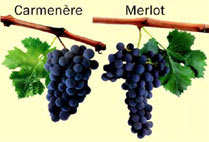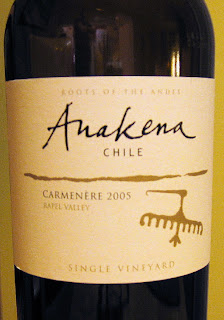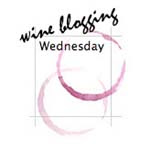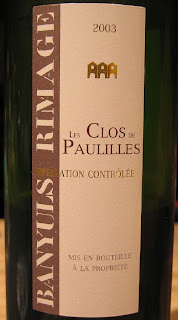
I decided a couple months ago or so that I wanted to learn more about
Rieslings. It was actually some of the sweeter, German -style Rieslings that really got me started on wine in the first place several years ago. I think as I learned more about different wines and transformed into a red wine drinker, I just unconsciously presumed the stuff I started on had to have been inferior, and I have sort of ignored it ever since.
Well, a couple weeks ago I started reading Andrea
Immer Robinson's
Great Wine Made Simple. As described by the subtitle of her book,
Straight Talk from a Master Sommelier, Andrea
Immer Robinson really knows her stuff and is completely unpretentious as she walks you through a series of several recommended tastings meant to help you develop your palate.
The first of these tastings is the "Big Six" - six grapes that represent the "guts" of about 80% of the quality wine sold in the U.S. There are three white grapes and three red grapes, each grape also representing the range of body (light, medium and full) of each type. In order of increasing body, the white grapes are Riesling,
Sauvignon Blanc and Chardonnay; the red grapes are
Pinot Noir, Merlot and Cabernet
Sauvignon.
When I read that, I thought"
Hmmm... I've had several wines made from all but one of those grapes within the last couple of years - Riesling. Am I missing out here?" As Robinson says, "First, ditch your snobbery about Riesling. A lot of people hear Riesling and think 'sweet' and 'no thanks.' My theory is that as soon as people spot the traditional long, thin bottle, they have flashbacks to
Liebfraumilch. But about the only thing great Rieslings have in common with Liebfraumilch is its traditional home base - Germany."
See, I told you she was unpretentious.
Anyway, that right there was enough to convince me that I needed to widen the (admittedly limited) horizons of my white wine world, and start tasting some Rieslings. With the hot and humid DC summers just right around the corner, when drinking my favorite red wines becomes all but unbearable, now seemed like the perfect time to start my exploration. So I did something I don't normally do - I bought this bottle of wine from the
cornerstore "
beermart" while picking up some
Cinco de Mayo
cervezas.
Why You Shouldn't Buy Wine at a "BeerMart"This was probably a mistake for several reasons, but the biggest one was how the wine had been stored. Being mainly a beer store, they have tons of beer-filled refrigerators which noisily and continuously remove heat from within the coolers and pump it out into the store. I'm just taking a guess here, but this heating effect probably keeps the temperature in this small shop in the upper 70s - not exactly ideal storage conditions for wine. Also, being mainly a beer store, they a) had a very poor wine selection, and b) almost never sold any wine - thus the bottles they did have had probably stewed there on those shelves for some time without being replaced by new stock.
All of this is to say that I probably didn't exactly "set myself up for success" for my re-entry into the world of Riesling. And when I first cracked open this 2004
Cousiño-Macul "Doña Isidora" Chilean Riesling, I must say I was not impressed. Since Kris and I had folks coming over to our place for a
Cinco de Mayo BBQ, I didn't have adequate time to chill the wine and attempted the "bottle in the freezer" trick which never seems to work out well. It was still far too warm when I first opened it, and therefore quite harsh. It was creamier than I was expecting, and had a bitterness to the finish which was not particularly pleasant. Oh well - time for a
Negra Modelo, and the Riesling was
pumped and put into the fridge.
The next night, my wife and I were having a grilled lemon pepper (
wild-caught) salmon, so I figured I'd break it out and try it again. Having been in the fridge all day, it would now be at a much more agreeable temperature which I hoped would rectify the many faults from my previous failed tasting attempt.
Wine in ChileBut first, let me tell you a bit about
Cousiño-
Macul. C-M grows the grapes used for their Riesling in the
Maipo Valley of Chile. Chile is in some ways the world's most ideal location for making consistent wines. Sandwiched by the Pacific Ocean and the Andes, it is protected from many of the pests that plague other vineyards of the world, most notably
Phylloxera.
Phylloxera attacks the roots of the
Vitis vinifera vine, and completely decimated the world's wine grape vines in the late 1800s. It was only by grafting
Vitis vinifera to native American
Vitis labrusca rootstock, which was resistant to
Phylloxera, that the wine industry was finally able to recover. But
Phylloxera never made it down to Chile, and thus grapes in this region are mostly pure,
ungrafted Vitis vinifera.
Another advantage that Chile's
winemaking regions have in terms of making consistent wines is that they are very arid (receiving less than 12 inches of rain per year), relying upon irrigation. Thus heavy rainfalls late in the season can't "dilute" the ripening grapes which typically makes for thinner wine. Simultaneously, these arid regions are virtually immune from drought as snow melt from the Andes provides a plentiful source for their irrigation.
Now, on to the wineWe selected this wine-on-a-whim because we have thoroughly enjoyed
Cousiño-
Macul's Antiguas Reservas Cabernet Sauvignon (although my favorite Chilean wine has been the
Carmenère - more on Chilean
Carmenères in a later post!) This 2004
Cousiño-Macul "Doña Isidora" Riesling had a syrupy golden-straw color to it. What surprised me about the taste of this Riesling is that although tart, there was also what I think of as creaminess to it. I was definitely not expecting to find that in a Riesling. This leads me to believe that perhaps I confuse body with creaminess, because the
tasting notes on
Cousiño-
Macul's website indicate that there was no
malolactic fermentation (a secondary fermentation that changes the tarter
malic acids into softer, creamier lactic acids), no aging in oak, nothing that would impart that cream.
So I wasn't that happy with this Riesling as a sipping wine. However, it paired quite nicely with our salmon. It's
citrusy, almost pineapple flavor with
minerally finish cut through the oily fish very nicely, cleansing the palate. Purchased for just $9 at the
beermart, I probably can't expect much more from it than that.
Final recommendationThe last Riesling I tasted was an Alsatian Riesling at the
FineWine.com tasting in April. That one was really good, and probably set my expectations a little high for this significantly cheaper Chilean Riesling. Before that, I can't even remember the last time I had Riesling. Thus I have a very limited mental Riesling library with which to compare the
Doña Isidora. All I can say is that the Chilean Riesling worked out OK with dinner, but was nothing spectacular. I'm still going to move ahead with my plan to try more Rieslings this summer, but would love to get some suggestions so that my next experience is a better one!
FootnoteKris and I are going to be starting in on the "Great Wine Made Simple" suggested palate-developing tastings, beginning with the Big Six tasting in two weeks! I have a
Domaine Trimbach Riesling from Alsace slated for that event - I'm hoping to go 2 for 2 on good Alsatian Rieslings! I'm excited to take a more directed approach to improving my palate, so I'll let you know how it goes!
 So German wines are a bit of a mouthfull to pronounce - probably part of their marketing problem in the U.S. This is definitely not an "easy" wine in name, region, or taste, so only the vinologically adventurous would likely seek this wine out for purchase.
So German wines are a bit of a mouthfull to pronounce - probably part of their marketing problem in the U.S. This is definitely not an "easy" wine in name, region, or taste, so only the vinologically adventurous would likely seek this wine out for purchase.


















